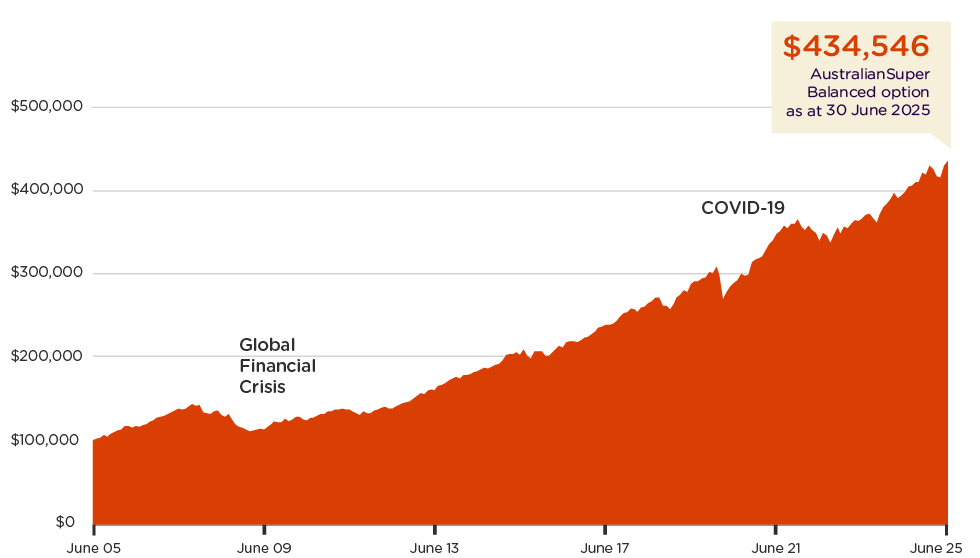24 June 2025
It’s valuable to understand what volatility is, what it means for your super and how we navigate market volatility for members.
What is market volatility
Volatility refers to the size and frequency of changes in investment prices – both up and down. It occurs when there are large swings in performance, often resulting from investor reactions to economic factors, company news or global events.
Volatility and investing
Market ups and downs are a normal part of investing. This is why we have a team of investment specialists who are highly experienced in managing member money through different market conditions and events.
It's important to note that while market volatility is often more noticeable in the short term, your super is a long-term investment. As the graph below shows, even significant market events, like the Global Financial Crisis and COVID-19 selloff, appear relatively smooth in the context of long-term growth over the last twenty years.
Performance through market events
Growth of $100,000 invested in Balanced option – super - over 20 years to 30 June 2025

AustralianSuper investment returns are based on crediting rates, which are returns less investment fees and costs, transaction costs, the percentage-based administration fee deducted from returns from 1 April 2020 to 2 September 2022 and taxes. Returns don’t include all administration, insurance and other fees and costs that are deducted from account balances. Returns from equivalent investment options of the ARF and STA super funds are used for periods before 1 July 2006. Investment returns aren’t guaranteed. Past performance isn’t a reliable indicator of future returns.
Portfolio diversification is key. Certain assets – like infrastructure, fixed interest and cash – can help cushion the portfolio during market downturns. We aim to position the portfolio to enjoy future upside when the markets recover. Diversification is a cornerstone of AustralianSuper’s long-term investment strategy and a key factor in maintaining resiliency in the face of market volatility.
The Fund employs active management throughout every stage of the market cycle. This means repositioning the portfolio as necessary throughout the cycle. When investment conditions look unfavourable, we reduce the risk in the portfolio – by reducing our exposure to growth assets, in favour of asset classes that carry lower levels of volatility. In addition, short-term volatility can often lead to the mispricing of assets. This means we’re searching for new investment opportunities with long-term intrinsic value.
LEARN MORE ABOUT THE BENEFITS OF ACTIVE MANAGEMENT
Staying calm when markets are not
In periods of increased market volatility, remember, super is a long-term investment. While it can be tempting to switch options when markets become volatile, being invested in a diversified portfolio over the long run can help grow your super.
If you’re concerned about changes to your balance and the impact on your retirement plan, consider speaking to an accredited financial adviser. This can help you review your retirement goals and identify the investment options that are best suited to you and your circumstances.
References:
- Personal financial product advice is provided under the Australian Financial Services Licence held by a third party and not by AustralianSuper Pty Ltd. Fees may apply.
Investment returns aren’t guaranteed. Past performance is not a reliable indicator of future returns.
This information may be general financial advice which doesn’t take into account your personal objectives, situation or needs. Before making a decision about AustralianSuper, you should think about your financial requirements and refer to the relevant Product Disclosure Statement. A Target Market Determination (TMD) is a document that outlines the target market a product has been designed for. Find the TMDs at australiansuper.com/TMD
Compare us
Choosing the right fund could mean more money in the future, giving you more confidence in your long-term retirement plan performance.
compare us